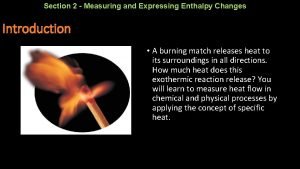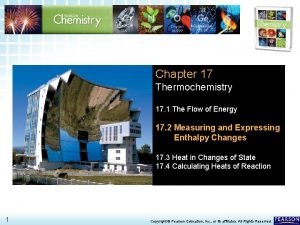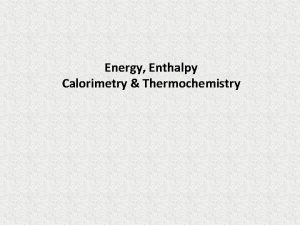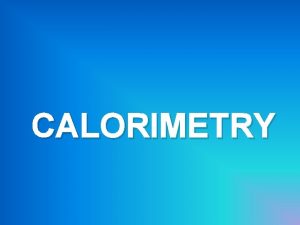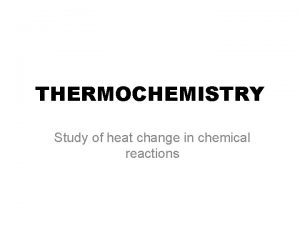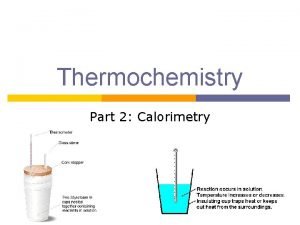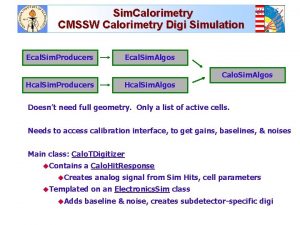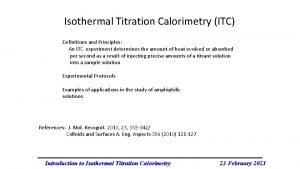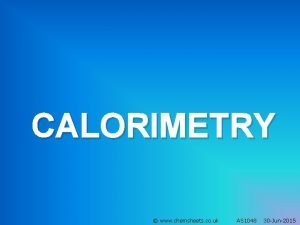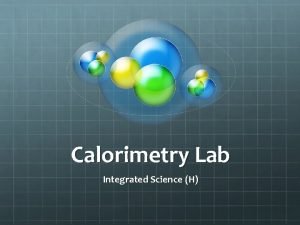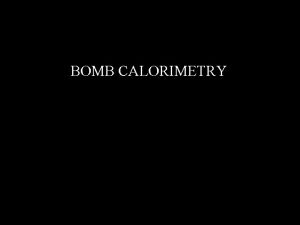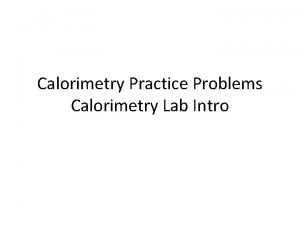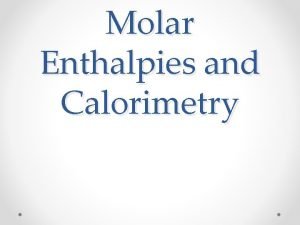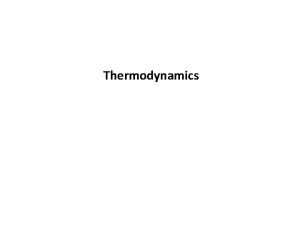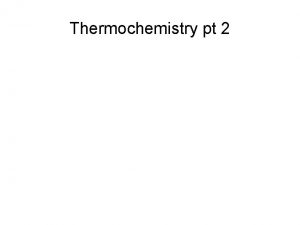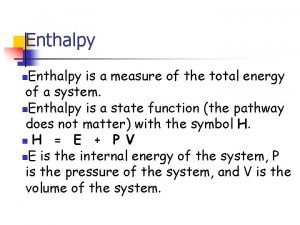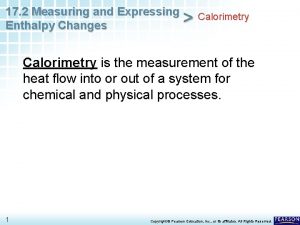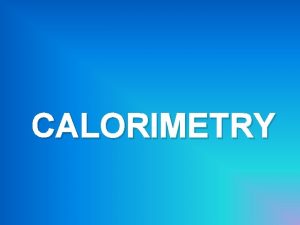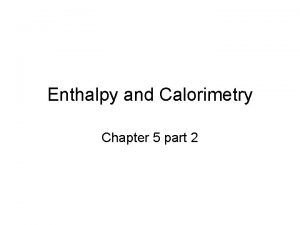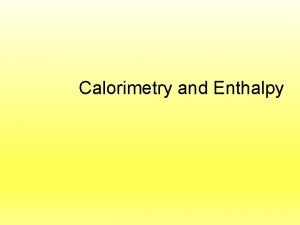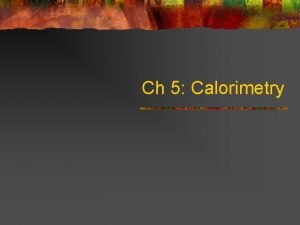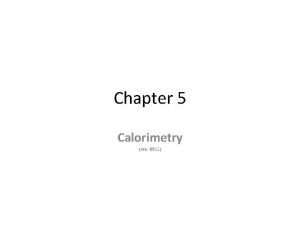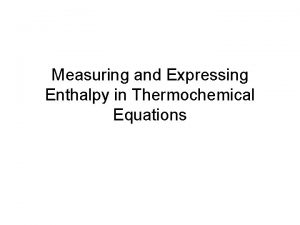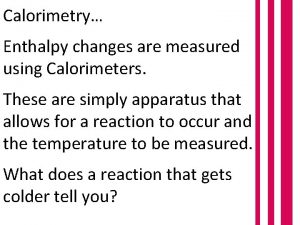17 2 Measuring and Expressing Enthalpy Changes Calorimetry





















- Slides: 21

17. 2 Measuring and Expressing Enthalpy Changes > Calorimetry is the precise measurement of the heat flow into or out of a system for chemical and physical processes. Slide 1 of 33 © Copyright Pearson Prentice Hall

17. 2 Measuring and Expressing Enthalpy Changes > Calorimetry In calorimetry, the heat released by the system is equal to the heat absorbed by its surroundings. Conversely, the heat absorbed by a system is equal to the heat released by its surroundings. Slide 2 of 33 © Copyright Pearson Prentice Hall

17. 2 Measuring and Expressing Enthalpy Changes > Calorimetry The insulated device used to measure the absorption or release of heat in chemical or physical processes is called a calorimeter. Slide 3 of 33 © Copyright Pearson Prentice Hall

17. 2 Measuring and Expressing Enthalpy Changes > Calorimetry Constant-Pressure Calorimeters The heat content of a system at constant pressure is the same as a property called the enthalpy (H) of the system. Slide 4 of 33 © Copyright Pearson Prentice Hall

17. 2 Measuring and Expressing Enthalpy Changes > Calorimetry Constant-Volume Calorimeters Calorimetry experiments can be performed at a constant volume using a bomb calorimeter. Slide 5 of 33 © Copyright Pearson Prentice Hall

SAMPLE PROBLEM 17. 2 Slide 6 of 33 © Copyright Pearson Prentice Hall

SAMPLE PROBLEM 17. 2 Slide 7 of 33 © Copyright Pearson Prentice Hall

SAMPLE PROBLEM 17. 2 Slide 8 of 33 © Copyright Pearson Prentice Hall

SAMPLE PROBLEM 17. 2 Slide 9 of 33 © Copyright Pearson Prentice Hall

Practice Problems for Sample Problem 17. 2 Problem Solving 17. 13 Solve Problem 13 with the help of an interactive guided tutorial. © Copyright Pearson Prentice Hall Slide 10 of 33

17. 2 Measuring and Expressing Enthalpy Changes > Thermochemical Equations How can you express the enthalpy change for a reaction in a chemical equation? Slide 11 of 33 © Copyright Pearson Prentice Hall

17. 2 Measuring and Expressing Enthalpy Changes > Thermochemical Equations In a chemical equation, the enthalpy change for the reaction can be written as either a reactant or a product. Slide 12 of 33 © Copyright Pearson Prentice Hall

17. 2 Measuring and Expressing Enthalpy Changes > Thermochemical Equations A chemical equation that includes the enthalpy change is called a thermochemical equation. Slide 13 of 33 © Copyright Pearson Prentice Hall

17. 2 Measuring and Expressing Enthalpy Changes > Thermochemical Equations The heat of reaction is the enthalpy change for the chemical equation exactly as it is written. Slide 14 of 33 © Copyright Pearson Prentice Hall

17. 2 Measuring and Expressing Enthalpy Changes > Thermochemical Equations Exothermic Reaction Slide 15 of 33 © Copyright Pearson Prentice Hall

17. 2 Measuring and Expressing Enthalpy Changes > Thermochemical Equations Endothermic Reaction Slide 16 of 33 © Copyright Pearson Prentice Hall

17. 2 Measuring and Expressing Enthalpy Changes > Thermochemical Equations The heat of combustion is the heat of reaction for the complete burning of one mole of a substance. Slide 17 of 33 © Copyright Pearson Prentice Hall

17. 2 Section Quiz. 1. The change in temperature recorded by thermometer in a calorimeter is a measurement of a. the enthalpy change of the reaction in the calorimeter. b. the specific heat of each compound in a calorimeter. c. the physical states of the reactants in a colorimeter. d. the heat of combustion for one substance in a calorimeter. Slide 18 of 33 © Copyright Pearson Prentice Hall

17. 2 Section Quiz. 2. For the reaction Ca. O(s) + H 2 O(l) Ca(OH)2(s), H = 65. 2 k. J. This means that 62. 5 k. J of heat is _____ during the process. a. absorbed b. destroyed c. changed to mass d. released Slide 19 of 33 © Copyright Pearson Prentice Hall

17. 2 Section Quiz. 3. How much heat is absorbed by 325 g of water if its temperature changes from 17. 0°C to 43. 5°C? The specific heat of water is 4. 18 J/g°C. a. 2. 00 k. J b. 3. 60 k. J c. 36. 0 k. J d. 360 k. J Slide 20 of 33 © Copyright Pearson Prentice Hall

17. 2 Section Quiz. 4. Which of the following is a thermochemical equation for an endothermic reaction? a. CH 4(g) + 2 O 2(g) CO 2(g) + 2 H 2 O(g) + 890 k. J b. 241. 8 k. J + 2 H 2 O(l) 2 H 2(g) + O 2(g) c. Ca. O(s) + H 2 O(l) Ca(OH)2(s) 65. 2 k. J d. 2 Na. HCO 3(s) 129 k. J Na 2 CO 3(s) + H 2 O(g) + CO 2(g) Slide 21 of 33 © Copyright Pearson Prentice Hall
 Measuring and expressing enthalpy changes
Measuring and expressing enthalpy changes Measuring and expressing enthalpy changes
Measuring and expressing enthalpy changes State and explain hess's law of constant heat summation
State and explain hess's law of constant heat summation Q= mc∆t
Q= mc∆t Molar enthalpy change
Molar enthalpy change Enthalpy change of combustion definition a level
Enthalpy change of combustion definition a level Elizabeth mulroney
Elizabeth mulroney Physical changes vs chemical changes
Physical changes vs chemical changes Calorimetry formula
Calorimetry formula Bomb calorimeter
Bomb calorimeter Pearson calorimetry simulation
Pearson calorimetry simulation Microscale combustion calorimetry
Microscale combustion calorimetry Isothermal titration calorimetry principle
Isothermal titration calorimetry principle Calorimetry 2 chemsheets answers
Calorimetry 2 chemsheets answers Food calorimetry virtual lab
Food calorimetry virtual lab Bomb calorimetry
Bomb calorimetry Calorimetry practice problems
Calorimetry practice problems Calorimetry lesson
Calorimetry lesson Calorimeter formula
Calorimeter formula Calorimetry
Calorimetry Bomb calorimetry equation
Bomb calorimetry equation Enthalpy is the measure of
Enthalpy is the measure of
